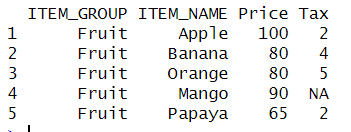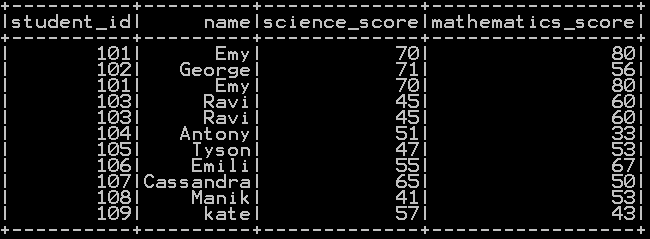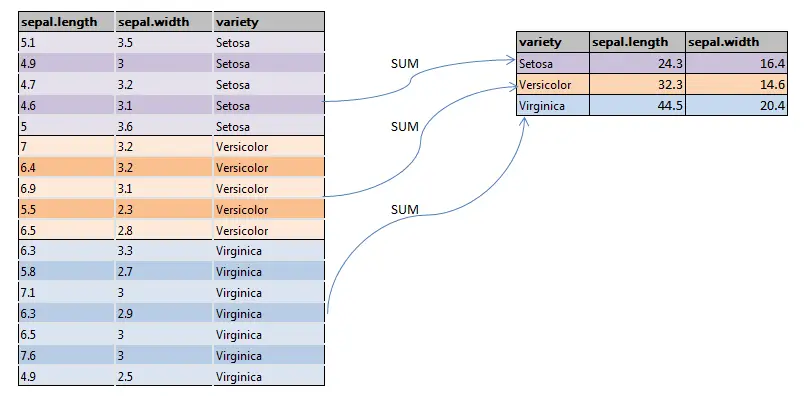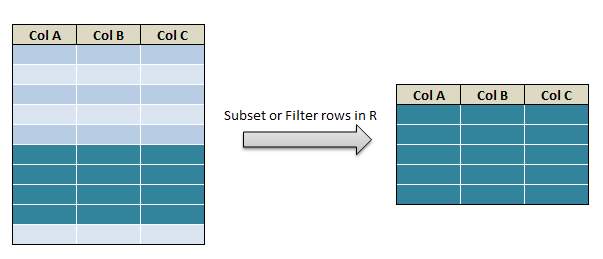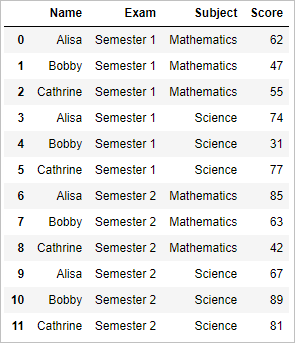%in% operator in R along with pipe operator is used for multiple purpose, one of its usage is that it is used to identify if an element belongs to a vector or Dataframe. Let see an example on how to use the %in% operator for vector and Dataframe in R.
- Use %in% operator to Check value in a vector.
- Use %in% operator to Check if one vector present in another vector.
- Check if any value in of one vector present in another vector.
- Check if all value in one vector present in another vector.
- Filter dataframe using %in% operator in R
- select column of a dataframe in R using %in% operator.
- create new variable of a column using %in% operator
- drop column of a dataframe in R using %in% operator.
USAGE of %in% Operator in R Vector:
Example of %in% operator in R for Vectors
Check if a value is present in the vector . Check Is value v1 present in the vector t.
# R %in% operator v1 <- 3 v2 <- 101 t <- c(1,2,3,4,5,6,7,8) v1 %in% t
In the above example v1 is present in t, so the output will be
[1] TRUE
# R %in% operator V2 %in% t
V2 is not present in t, so the output will be
[1] FALSE
Check if one vector present in another vector:
# R %in% operator vec1 <- c(1,3,4,5,13,33,79,43) vec2 <- c(1,2,5,34) vec2 %in% vec1
Check Vector vec2 is present in the vector vec1, so the output will be
[1] TRUE FALSE TRUE FALSE
Check if any value in of one vector present in another vector:
# R %in% operator vec1 <- c(1,3,4,5,13,33,79,43) vec2 <- c(1,2,5,34) any(vec2 %in% vec1)
Check if any value of Vector vec2 is present in the vector vec1, so the output will be
[1] TRUE
Check if all value in of one vector present in another vector:
Example 1:
# R %in% operator vec1 <- c(1,3,4,5,13,33,79,43) vec2 <- c(1,2,5,34) all(vec2 %in% vec1)
Check if all values of vector vec2 is present in the vector vec1, so the output will be
[1] FALSE
Example 2:
# R %in% operator vec1 <- c(1,3,4,5,13,33,79,43) vec2 <- c(1,5,34) all(vec2 %in% vec1)
Check if all values of vector vec2 is present in the vector vec1, so the output will be
[1] TRUE
Get the Index of the Vector using %in% operator in R:
Example 1:
To Get the index of the vector in R, we use %in% operator along with which() function.
# R %in% operator vec1 <- c(1,3,4,5,13,33,79,43) which(vec1 %in% 13)
which() function will take the value and returns the position of value in the vector vec1, so the output will be
[1] 5
Example 2:
To Get the index of the vector, we use %in% operator along with which() function.
# R %in% operator vec1 <- c(1,3,4,5,13,33,79,43) which(vec1 %in% 4)
which() function will take the value and returns the position of the value in vector vec1, so the output will be
[1] 3
USAGE of in Operator in R Dataframe:
Create column using %in% operator in R:
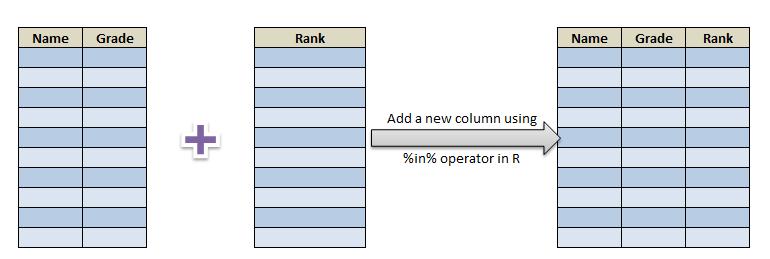
Lets create my_basket dataframe in order to depict an example of create column using %in% operator and some other operations
### Create dataframe in R
my_basket = data.frame(ITEM_GROUP = c("Fruit","Fruit","Fruit","Fruit","Fruit","Vegetable","Vegetable","Vegetable","Vegetable","Dairy","Dairy","Dairy","Dairy","Dairy"),
ITEM_NAME = c("Apple","Banana","Orange","Mango","Papaya","Carrot","Potato","Brinjal","Raddish","Milk","Curd","Cheese","Milk","Paneer"),
Price = c(100,80,80,90,65,70,60,70,25,60,40,35,50,60),
Tax = c(2,4,5,NA,2,3,NA,1,NA,4,5,NA,4,NA))
my_basket
so the resultant dataframe will be
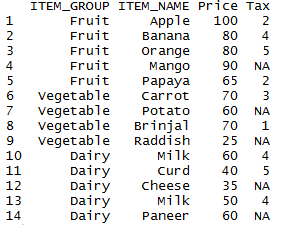
now lets use %in% operator to create a new variable
### Create a new variable using %in% operator in R
my_basket1=within(my_basket,{
IS_DAIRY='NO'
IS_DAIRY[ITEM_NAME %in% c('Milk',"Curd","Cheese","Paneer")]='YES'
IS_DAIRY[ITEM_GROUP %in% c("Dairy")]='YES'
IS_DAIRY[ITEM_GROUP %in% c("Fruit","Vegetable")]='NO'
})
my_basket1
In order to create a new variable namely “IS_DAIRY“, we will be using %in% operator which will assign YES if the ITEM_GROUP is Dairy or ITEM_NAME is Dairy products. Else it will assign NO.
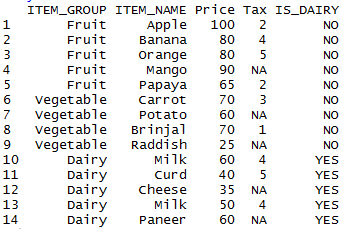
Filter dataframe using %in% operator
### Filter a dataframe using %in% operator in R
df_filter<- my_basket [my_basket$ITEM_GROUP %in% c('Fruit'), ]
df_filter
In order to perform filter we will be using in operator and stored into a new dataframe. using %in% operator which will filter Fruit in ITEM_GROUP Column. so the resultant dataframe will be
Drop column using %in% operator
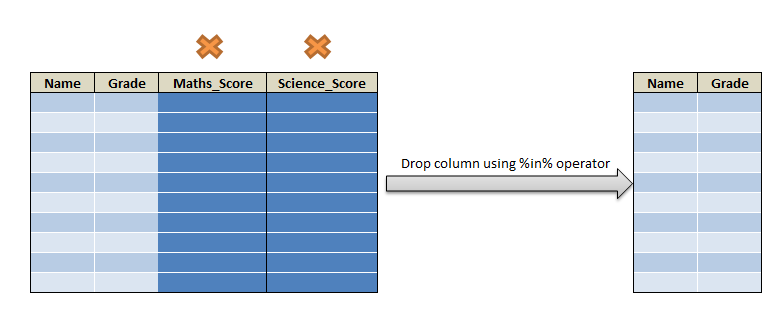
dropping a column can also accomplished using %in% operator as shown below.
### Drop column using %in% operator in R
my_basket[, !(colnames(my_basket) %in% c("Tax"))]
we will be dropping a column name that has “Tax”, so the resultant table will be
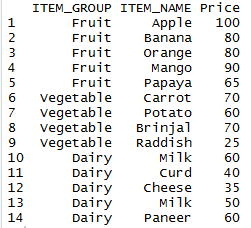
select columns using %in% operator
selecting column names can also accomplished using %in% operator, as shown below. which selects the list of column names using select_if() function along with pipe(%>%) and %in% operator.
### select columns using %in% operator in R
my_basket %>%
select_if(names(.) %in% c('Price', 'ITEM_GROUP', 'ITEM_NAME'))
we will be selecting some column names , so the resultant table will be

Other Related Topics:
